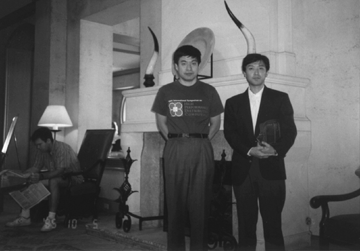
Visitor: Takashi Yokota (TRC Massively Parallel Architecture Laboratory) Period: October 1 - 12, 1995 (12 days) Places (attended conferences): International Conference on Computer Design (ICCD '95), Texas Instruments Ltd., University of California at Berkeley, Stanford University
The main purposes of my trip to the United States were to make a presentation at the International Conference on Computer Design (ICCD '95), to visit Texas Instruments Ltd. to investigate the trend on VLSI/ASIC technologies and the current status of the latest studies at the University of California at Berkeley and Stanford University.
The ICCD '95 is an international conference sponsored by the Computer Society and the Circuits and Systems Society of IEEE. The ICCD '95 was held for three days from October 2 through 4 at a hotel in Austin, Texas. All the papers were collected and reviewed according to their respective subjects, and classified into six categories such as "Architecture and Algorithms," "Computer-Aided Design," "Data Communication and Networking," "Design and Test," "Embedded Systems "and "VLSI." When you read the selected papers, you will quickly see that they all are very advanced and of very high quality.
I had the opportunity to provide a presentation under the title "A Prototype Router for the Massively Parallel Computer RWC-1" on the afternoon of October 3. In this paper, I introduced the architecture and design of a network chip for RWC-1 that is developed at the TRC Massively Parallel Architecture Laboratory. RWC-1 employs a unique network topology called "Multidimensional Directed Cycles Ensemble extension (MDCE)." So, my presentation always starts with an explanation of the MDCE network. This time was no exception and I really worked hard to confine my presentation within the allowed period of 30 minutes (20 minutes for the presentation and 10 minutes for the Q and A session). I mentioned MDCE in a very brief manner to make only the essential points clear. I think that it helped the audiences understand my unskilled English presentation.

As indicated by the title, this conference covered an extensive range of computer design technologies including VLSI, CAD and architecture. All papers were highly sophisticated, and the participants included leading researchers and developers around the world. According to one official, some 230 took part in this conference. Though many conferences are held the world over, ICCD is a unique conference for its wide research areas as well as excellent papers. I enjoyed enlightened conversations with other participants during the intermissions between sessions. However, 39 sessions were scheduled for the conference of two and a half days and my only regret about the conference was that in most cases four general sessions were conducted simultaneously and I missed some interesting sessions.
After the ICCD '95, I flew to Dallas on October 6 to learn about leading-edge VLSI/ASIC technology at Texas Instruments Ltd. On October 9 and 10, I visited Professor Cullar of the University of California at Berkeley and Professor Gupta of Stanford University respectively to explain the status of RWC-1 and discuss their research.
During the trip, I noticed that the hotel rooms I stayed were equipped with a modem connector. I made up my mind to bring my portable PC for the next trip because I found more than 100 and dozens of e-mail in my mailbox when I returned home.